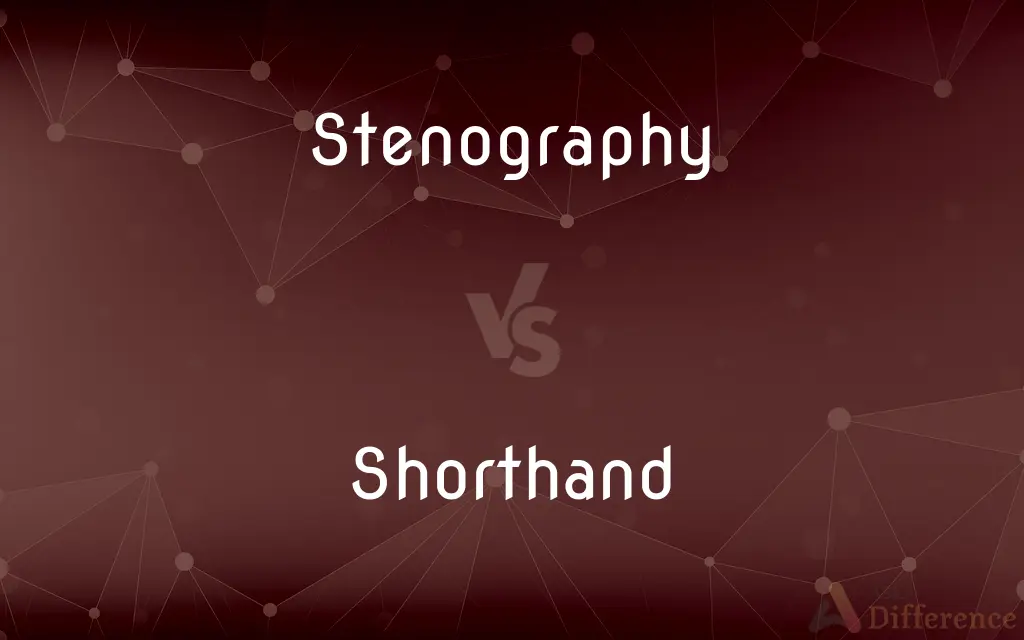Stenography vs. Shorthand — What's the Difference?
By Tayyaba Rehman & Maham Liaqat — Updated on April 3, 2024
Stenography is a method of transcribing speech at high speeds using specialized machines or software, while shorthand is a writing technique that uses abbreviated symbols to represent words or phrases.

Difference Between Stenography and Shorthand
Table of Contents
ADVERTISEMENT
Key Differences
Stenography, often used in legal and professional settings, involves the use of stenotype machines or computer software to capture spoken words at speeds matching normal speech. These systems typically require extensive training to operate efficiently. On the other hand, shorthand is a manual writing system that simplifies letters, words, and phrases into symbols, allowing for rapid note-taking. Shorthand systems, such as Gregg or Pitman, are learned through practice and are used in a variety of contexts, including journalism and secretarial work.
While stenography equipment can be expensive and requires technical knowledge for operation and maintenance, shorthand requires only a pen and paper, making it accessible and cost-effective. However, the speed and efficiency of stenography, especially in capturing verbatim transcripts in real-time, are unparalleled. Conversely, shorthand's effectiveness is largely dependent on the writer's skill and proficiency, which can vary widely.
Stenography's output is often digital, which facilitates easy editing, storage, and transmission of the transcribed text. This digital nature suits modern workflows, particularly in court reporting and closed captioning for broadcast media. Shorthand, while primarily analog, offers the advantage of being more discreet and portable, as it can be used anywhere without the need for equipment.
In terms of learning curve, stenography is considered more challenging due to the complexity of the machines and software. Mastery of stenography typically requires formal education and certification. Shorthand, although it also has a steep learning curve, can be self-taught or learned through less formal training programs, making it more accessible to a broader audience.
The choice between stenography and shorthand often depends on the specific requirements of the task, including the need for speed, the method's intrusiveness, and the context in which it is used. Legal proceedings and live broadcasting lean towards stenography for its accuracy and speed, while journalism and personal note-taking might favor shorthand for its simplicity and portability.
ADVERTISEMENT
Comparison Chart
Equipment
Stenotype machines or software
Pen and paper
Speed
Matches speech; up to 225 words/minute
Varies by proficiency; generally slower
Output
Digital text
Handwritten symbols
Contexts
Legal, broadcasting
Journalism, personal notes
Learning Curve
High; formal education often required
Moderate; can be self-taught
Cost
High initial investment
Minimal
Portability
Requires equipment
Highly portable
Editing
Easy digital editing
Manual transcription needed
Efficiency
High; accurate real-time transcription
Dependent on writer’s skill
Compare with Definitions
Stenography
The practice of transcribing speech using a stenotype machine.
Court reporters use stenography to transcribe trials.
Shorthand
A writing system that uses abbreviated symbols.
Journalists sometimes use shorthand to take fast notes.
Stenography
Involves real-time transcription at speech speed.
Stenography enables live broadcasting captions.
Shorthand
Learned through practice and memorization.
Many secretaries were historically trained in shorthand.
Stenography
Requires specialized equipment or software.
Professional stenography often uses computer-aided transcription systems.
Shorthand
Primarily analog and requires transcription.
Shorthand notes must be transcribed into longhand for most uses.
Stenography
Produces digital transcripts.
Stenography outputs can be easily edited and shared electronically.
Shorthand
Useful in various note-taking contexts.
Students and professionals use shorthand for efficient note-taking.
Stenography
Used in legal and broadcasting contexts.
Stenographers are essential for producing official transcripts in courtrooms.
Shorthand
Enables quicker manual writing.
Shorthand techniques can double or triple writing speed.
Stenography
The art or process of writing in shorthand.
Shorthand
Shorthand is an abbreviated symbolic writing method that increases speed and brevity of writing as compared to longhand, a more common method of writing a language. The process of writing in shorthand is called stenography, from the Greek stenos (narrow) and graphein (to write).
Stenography
Material transcribed in shorthand.
Shorthand
A system of rapid handwriting employing symbols to represent words, phrases, and letters.
Stenography
The practice of transcribing speech (primarily for later dictation or testimony), usually using shorthand
Shorthand
A system, form, or instance of abbreviated or formulaic reference
"The classical error is to regard a scientific law as only a shorthand for its instances" (Jacob Bronowski).
Stenography
The art of writing in shorthand, by using abbreviations or characters for whole words; shorthand.
Shorthand
A rough and rapid method of writing by substituting symbols for letters, words, etc.
Stenography
A method of writing rapidly
Shorthand
(by extension) Any brief or shortened way of saying or doing something.
The jargon becomes a shorthand for these advanced concepts.
Stenography
The act or art of writing in shorthand;
Stenography is no longer a marketable skill
Shorthand
(transitive) To render (spoken or written words) into shorthand.
Shorthand
To use a brief or shortened way of saying or doing something.
Shorthand
(intransitive) To write in shorthand.
Shorthand
A compendious and rapid method or writing by substituting characters, abbreviations, or symbols, for letters, words, etc.; short writing; stenography. See Illust. under Phonography.
Shorthand
A method of writing rapidly
Shorthand
Written in abbreviated or symbolic form;
Shorthand notes
Common Curiosities
Is stenography the same as shorthand?
No, stenography involves machine or software for transcribing speech, while shorthand is a manual, symbol-based writing system.
Which is more expensive to learn and use, stenography or shorthand?
Stenography requires a significant initial investment in equipment and formal training, making it more expensive than shorthand, which only needs pen and paper.
Can shorthand be as fast as stenography?
Shorthand speed varies by individual skill, but stenography typically allows for faster and more accurate transcription.
Can stenography output be edited?
Yes, stenography often produces digital text, which is easily editable.
Are there different types of shorthand?
Yes, there are several shorthand systems, including Gregg and Pitman, each with its own symbols and rules.
Do I need formal training to learn shorthand or stenography?
Stenography usually requires formal training due to its complexity, whereas shorthand can be self-taught or learned through various courses.
Which is better for courtroom reporting, stenography or shorthand?
Stenography is preferred for courtroom reporting due to its speed and accuracy in capturing verbatim dialogue.
Are stenography and shorthand still relevant in the digital age?
Yes, both are used for tasks where rapid transcription of spoken words is necessary, such as in legal, journalistic, and broadcasting fields.
Can anyone learn stenography or shorthand?
Yes, with dedication and practice, most people can learn either system, though stenography has a steeper learning curve.
Can stenography be used for languages other than English?
Yes, stenography can be adapted for other languages, though it may require specific stenotype keyboards or software configurations.
How long does it take to become proficient in shorthand or stenography?
Proficiency in stenography can take years of formal education, while shorthand proficiency can vary but generally requires less time to learn.
Is shorthand applicable in digital note-taking?
While primarily analog, shorthand skills can complement digital note-taking, especially for quick initial drafts or when digital devices are impractical.
How do stenography and shorthand compare in terms of efficiency?
Stenography is generally more efficient for real-time transcription, while shorthand's efficiency depends on the writer's skill level.
Is digital transcription replacing stenography and shorthand?
While digital transcription tools are becoming more common, stenography and shorthand remain valuable for their real-time accuracy and reliability.
How has technology impacted the practice of stenography and shorthand?
Technology has enhanced stenography with digital tools and software, while also offering new ways to learn and apply shorthand more efficiently.
Share Your Discovery

Previous Comparison
Shareholder vs. Partner
Next Comparison
Pimple vs. CystAuthor Spotlight
Written by
Tayyaba RehmanTayyaba Rehman is a distinguished writer, currently serving as a primary contributor to askdifference.com. As a researcher in semantics and etymology, Tayyaba's passion for the complexity of languages and their distinctions has found a perfect home on the platform. Tayyaba delves into the intricacies of language, distinguishing between commonly confused words and phrases, thereby providing clarity for readers worldwide.
Co-written by
Maham Liaqat















































